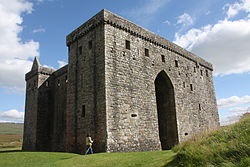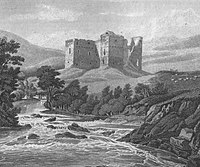Hermitage Castle
| Hermitage Castle | |
|
Roxburghshire | |
|---|---|
 Hermitage Castle | |
| Type: | 1. Motte and bailey 2. Tower house/keep with barmkin |
| Location | |
| Grid reference: | NY495960 |
| Location: | 55°15’20"N, 2°47’36"W |
| Village: | Newcastleton |
| History | |
| Built c.1240, mid 14th century | |
| Information | |
| Condition: | Partially ruined |
| Owned by: | Historic Scotland |
Hermitage Castle is a semi-ruined castle in Roxburghshire. It is under the care of Historic Scotland. The Castle has a reputation, both from its history and its grim, uncompromising appearance, as one of the most sinister and atmospheric in Britain.
It is thought that the name 'Hermitage' derives from Old French: l'armitage – guardhouse. The castle was known as the guardhouse of the bloodiest valley in Britain, and the "Strength of Liddesdale".
History
Hermitage Castle was supposedly built by one Nicholas de Soulis around 1240, in a typical Norman Motte and Bailey pattern. It stayed in his family until approximately 1320, when his descendant, William de Soulis forfeited it because of suspected witchcraft and the attempted regicide of King Robert I of Scotland.
Legend has it that Soulis' tenantry, having suffered unbearable depredations, arrested William, and at the nearby Ninestane Rig (a megalithic circle), had him boiled to death in molten lead. In actuality, he died, a prisoner, in Dumbarton Castle. Hermitage Castle is thus reputed to be haunted by Redcap Sly, de Soulis's familiar spirit.[1]
Under the Douglases
In 1338, the castle was held by an English garrison, commanded by Sir Ralph de Neville when it was besieged by Sir William Douglas, The Knight of Liddesdale, known as the "Flower of Chivalry" (this sobriquet had to do with his abilities as a knight, although it is often misinterpreted by people with a rather romantic view of history).
Upon the death of Sir William, brought about by near kinsman and namesake, William Douglas, 1st Earl of Douglas, the Castle fell into the hands of the Dacre family for a time. It soon fell back into the hands of Earl William through inheritance, and it was he that enabled the construction of most of the present building, possibly with the help of John Lewin, master mason at Durham Cathedral. The Earl's sons provided the seed of the two famous branches of the house – the 'Black' (for Earls of Douglas) and 'Red' (for the Earls of Angus). By 1455 the Black line had so incensed the King that James Douglas, 9th Earl of Douglas was forfeited, never to return, and the beneficences that they had enjoyed passed to the 'Red' line of Angus, including Hermitage Castle.
Under the Hepburns
King James IV was suspicious of the then Earl of Angus, Archibald, Bell the Cat and his relationship with Henry VII of England, and ordered him to resign The Hermitage to the Crown. On 6 March 1492, Patrick Hepburn, 1st Earl of Bothwell had a charter of the lands and lordship of Liddesdale, including The Hermitage Castle, etc., upon the resignation of the same by Archibald Douglas, Earl of Angus, the latter getting the lordship of Bothwell (but not the Earldom) which Patrick in turn had resigned for the exchange. The Hepburns of Bothwell, then rising in favour with the king, became keepers and lords of The Hermitage.
In time, James Hepburn, 4th Earl of Bothwell held the castle. Mary, Queen of Scots, made a famous marathon journey on horseback to visit the wounded Bothwell there, only a few weeks after the birth of her son. They were to marry shortly after the murder of her 2nd husband Henry Stuart, Lord Darnley, regardless of the fact that Bothwell was implicated amongst the conspirators. After Mary's forced abdication following the confrontation at Carberry Hill, Bothwell, facing charges of treason, fled to Norway and his titles and estates were forfeited by Act of Parliament. Whilst attempting to raise an army to restore Mary to the throne, he was arrested by King Frederik's men for breach of marriage contract with Anna Throndsen, and imprisoned at Dragsholm Castle in Denmark, where he died insane and in appalling conditions. His mummified body can still be seen at nearby Fårevejle Church.
Bothwell's nephew, Francis Stewart, 1st Earl of Bothwell received a new creation as Earl of Bothwell, and Keeper of the castle. A grandson of James V, albeit through an illegitimate line, he was viewed by some as a potential replacement for James VI. In 1591, Bothwell was arrested, tried, gaoled and forfeited for his supposed involvement with the infamous North Berwick Witches. He obtained a pardon in 1593 but again became involved in intrigue and he was again attainted, by Act of Parliament, on 21 July 1593. The Hermitage once again reverted to the Crown.
Under the Scotts
The following year, James granted the castle to Sir Walter Scott of Buccleuch, known as "the bold Buccleuch". A notorious Border reiver, Warden of the western marches, Keeper of Liddesdale, he was the leader of the daring and infamous attack on Carlisle Castle to rescue Willie Armstrong of Kinmont.
Decline

The castle became obsolete after the Union of the Crowns, in 1603 and fell into disrepair, by the turn of the eighteenth century it was a ruin. Hermitage gave its name to the Viscountcy of Hermitage, conferred in 1706 on Henry, third son of the first Duke of Buccleuch as a subsidiary title of the Earldom of Deloraine. This title became extinct in 1807. Some repairs to the castle were carried out in 1820 by the fifth Duke of Buccleuch.
It is interesting to note that the Scotts are descended matrilinearly from the Douglases of Drumlanrig, a cadet branch, and sometimes use the surname Montagu-Douglas-Scott, thus maintaining a continuity with earlier times.
Today
The castle remained a property of the Scotts until 1930, when it was handed over to the care of the Nation. It is now cared for by Historic Scotland.
Pictures
-
Hermitage Castle seen from the ruined chapel
Outside links
| ("Wikimedia Commons" has material about Hermitage Castle) |
- 149
- CANMORE (RCAHMS) record of Hermitage Castle Ancient Deer Park
- Hermitage Castle Near Newcastleton
- Hermitage Castle & Mary, Queen of Scots
- The Border Reivers
- Ghostly Hermitage
- Lordbothwell.co.uk






